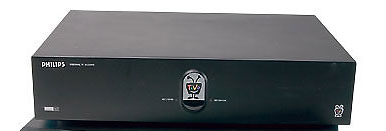This is the TiVo HDR110. If you were lucky enough in 1999, and you had a thousand bucks in your pocket, you could own this revolutionary DVR. It was a fairly large beast, but not a whole lot larger than a DIRECTV Genie DVR.
The specs for this DVR were formidable for the day, but a little laughable today. Its 13GB hard drive gave you the choice of roughly 6, 12, or 24 hours of recording, but all recordings were encoded on the fly and if you wanted standard-definition quality you needed that 6-hour mode. Anything less gave your recordings a distinctly YouTube-like appearance. (Not that YouTube had been invented yet.)
That’s right, the first TiVo gave a a choice of SD quality or two levels worse than SD quality. But who cared? You could PAUSE LIVE TV for goodness sake!
Back when such things were important, TiVos had a built-in RF modulator to work with any television, as well as a full complement of composite and S-Video ports.
The way TiVo’s worked in those days was a little confusing. If you had a cable or satellite box capable of serial control, then you hooked a cable to that tuner and TiVo could control it. Otherwise you had to rely on whatever internal timers were available on the cable or satellite box you had. Off-air recordings could be scheduled directly.
There was another little hitch. You see, the TiVo had one tuner. That meant one recording at a time. If the TiVo needed to control the cable box, it meant no watching one channel and recording another. If you wanted that capability, you needed to resort to multiple cable boxes and A/B switches, much as you would do with the VCRs of the day.
As a replacement for a VCR, TiVos back in 1999 were less than fantastic. For $1,000, you could get a very fancy VCR with multiple timers, editing capabilities and variable-speed fast forward/rewind. You also had infinite recording and storage capacity… just take one tape out and put another in. TiVo did a lot of the work for you and gave you a nice guide and list, but believe it or not, a $150 VCR of the day was a better choice.
That didn’t last long of course. TiVo and its competitors killed the VCR rather handily by mid-decade, and by 2009, the VCR with its analog-only recordings was pushed aside by digital television. By then, TiVos and other DVRs had features that folks in 1999 only dreamed of.





